1. A night before the birth of V-twin
At first, I'd like to suggest about two projects of MOTO
GUZZI V-twin, that precede to the one of motorcycle. That would be a
good step to understand the story of GUZZI motorcycle V-twin.
1.1 Historical backgrounds
In a postwar rehabilitation period of Italy, in 1940-50's,
small motorbike was very popular as a cheap transporter that brings
carriage and human, and a delight recreation that brings freedom.
Its market was rich, and fed many motorcycle makers, not only the old
ones from prewar, but also new ones set up in those days.
Also MOTO GUZZI enjoyed spring. More than 340,000 units of Motoleggera,
Calderino, Zigolo, was produced, and they had a good reputation for
light, high performance, simple, and reliable.
Those small bikes, which were designed by Antonio Micucci, can be
characterized technically with its unique rear suspension system, long
life engine like bigger GUZZI brothers, and there was also a management
fruit like a joint established in Spain.
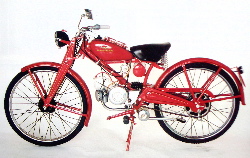
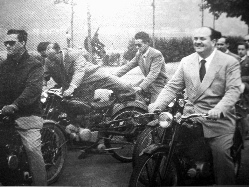
left : an example of MOTO GUZZI Hispania 65 cc (reference No. 7)
right : Mandello rally in 1949. Most right is Enrico Palodi (seems to
be enjoying much), most left is Umberto Todero with sunglasses. (ref.
No. 1)
However, those happy days did not continue much longer.
After that period, increasing people's income level, and price of cars
dropped. Most of the motorbike market was brought away to cars, and
being limited to small mopeds and scooters. Many bike makers were
exhausted under that sort of hard situation.
In those days, 1955.
In a design room of MOTO GUZZI, there was a man, who was drawing a big
4 stroke V twin engine. He was Micucci, who designed the dominating
moped, Motoleggera.
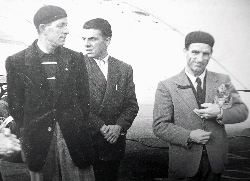
In 1948, Isle of Mann.
From left, Moletto (chef mechanic), Micucci, Omobono Tenni and Manx cat. (ref. No. 5)
1.2 Military special vehicle 3X3
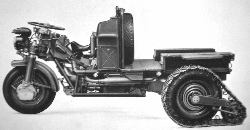 An example of 3X3 (ref. No. 1)
An example of 3X3 (ref. No. 1)
Sometimes it's bantered as a farmer tractor, I'd like to list up this
special vehicles feature to aid such a ignorance.
- At the beginning of 1950's, Garbari, later general, proposed it for transport in Alps mountains.
- It has tree wheels, one for front, two for rear. All tree wheels are driven.
- Its driving interface is like cars. It has round steering wheel and a few foot pedals.
- Driver sits on the seat like saddle. The engine is mounted at the behind of the seat.
- Rear tire tread varies. And also the caterpillar can be attached to improve the rough road availability.
- Engine torque is divided 1 : 4 to run front and rear wheel respectively, through special differential gear.
- Its body is constructed with welded structure of big cross-section tube and pressed steel plate.
At this time MOTO GUZZI already has some kind of working vehicles like
Motocarro, Ercolino, and the 3X3 structure can be said as a
evolutionary version of them.
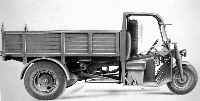 One example of Ercole (ref. No. 1)
One example of Ercole (ref. No. 1)
3X3 is for one person, and since it's applied to the rough road of Alps,
It could do quick or small turn, so 3X3 is not so big. It seems to be
the same size as the trikes of nowadays.
There were two types of 3X3.
First type appeared in 1955 or 56, which was designed by the team of
Micucci. That was a prototype, with 700 cc engine of single camshaft
between the cylinders, and crank case was divided vertically. Engine
was set as a bit vivace, preferred high rpm. A few or tens of units
seemed to be delivered.
Next new was for mass production type, which was re-designed after
1958. Joined Umberto Todero, who was said as the right-hand-man of
Carcano, reinforced design team. Engine was a bit extended to 750 cc,
with two camshafts beside the each cylinder, and the crank case was a
single piece structure with dome shape. It was focused on the
durability and tolerance, engine was set modestly, Production started
from 1960, and about 200 units were made.
The engine of 3X3 is a MOTO GUZZI's first 90 degree V twin. Transverse
mounting and OHV system is same with the later motorcycle V twin, so it
could be confused as its ancestor. But they have little similarity,
their architecture is quite different. They don't have technical
relation. They two are quite different productions.
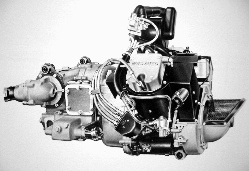 The engine of 3X3 (ref. No. 1)
The engine of 3X3 (ref. No. 1)
Now, let's see the 3X3 again carefully.
It's quite unique, interesting vehicle (or a weapon?). It has so
complex mechanism in those days, and it can be said as a proof of
high technical level of MOTO GUZZI.
I also like to point a fact that the Italian army let this project to
MOTO GUZZI. Under the world war II condition, almost all of the
motorbike makers may have a connection to the army, but it selected
just a GUZZI. You can say some reasons, ex., the factory of GUZZI was
safe beyond the war, it places near the Alps which is the object land
of this project, etc., but it's difficult to say the definite one. I'd
say that the special connection between the GUZZI and Italian
authorities as a result of long history of the GUZZI may make affect to
the vendor selection. Because that relation will affect again to the
background of the next V7 motorbike development.
Well, I can't say clearly how this vehicle did work as a weapon. It has
produced about 200 units, it's too little against the level of Ercore,
over 30,000 units. So it was not much profitable for MOTO GUZZI. But
its mechanism and poor production may appeal as a collection item. If
you are a true vehicle collector, it is the must one. (Just a joke...)
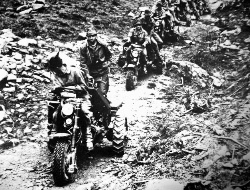
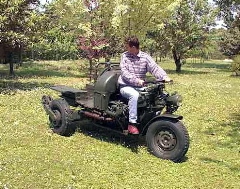
left : 3X3 in Alps (ref. No. 1)
right : 3X3 nowadays (fm MOTO GUZZI user site; already closed.)
1.3 Development a engine for FIAT 500
MOTO GUZZI racing team stopped GP atcivity at the end of
1957, and next year, some projects were started. The development of
FIAT 500 engine was one of them.
I can't say there's any clear agreement between the GUZZI and FIAT at
the start of the project. But technically, it had clear consistency,
which is the development of high performance engine unit with the
original gearbox of FIAT 500.
In 1958 it was started with the shape of OHV 90 degree V-twin 500 cc,
air-cooled by the fins driven by the engine itself. One cam placed
between the cylinders and it moves all the valves. Some design updates
were carried out to achieve good performance, reliability, and easy
maintenance, especially after 1960 when the development of 3X3 was
finished. After 1961, the engine was tested not only on the test bench
but also mounted in a real car. Displacement became 600 cc to cope with
the ABARTH, and 36ps 130km/h was achieved at the end of 1963.
After that, some samples were sent to FIAT and evaluated. It was
appreciated well, especially for its performance, but that's all. Test
car was sent back and GUZZI could not get any further offer.
GUZZI's dream, perhaps it was a seed of next mass production
engineering, was shut down by FIAT.
But the engine provides a proof that they could make up a good example
for a technical level of car production. Managers may be pale, but
engineers was not.
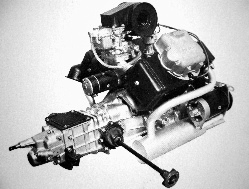 FIAT 500 engine (ref. No. 1)
FIAT 500 engine (ref. No. 1)
This engine has many technical similarity for V7, the motorcycle that
comes after it. But it's wrong to conclude that GUZZI reused this widow for
V7, because V7 was developed parallel time with FIAT. They were
independent project.
So the engine for FIAT 500 and V7 differs much, different displacement,
and no common parts. You'll have much difficulty if you want to make V7
engine into the FIAT engine room.
Well, you can image them freely though. It would be amazing that brave GUZZI
engine works hard under the bonnet of that pretty FIAT 500.
I've found a good example shown below. It was mounted laterally rotated
compared to the Carcano's genuine one. It's wonderful, but seems hardly
to be cooled.
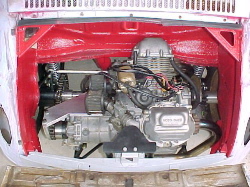 see detail to http://www.mgcn.nl/dameijer/html/fiat500.htm
see detail to http://www.mgcn.nl/dameijer/html/fiat500.htm
1.4 Overview
MOTO GUZZI seems struggled in this era, around 1957 of quitting the GP.
Someone says it's because the decreased income after the motorbike market
shrinkage. If that was true, MOTO GUZZI might try to get another market.
In those era, MOTO GUZZI made various project, which contains special
vehicles that may have some relations to the 3X3, and speed record attackers
of special architecture.
All these examples show high capability of MOTO GUZZI design team that
had made so many racing bikes for various classes just before that time.
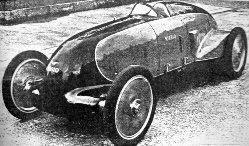
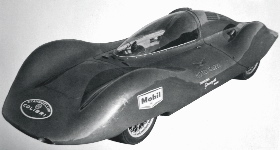
Examples of speed record vehicles that MOTO GUZZI dedicated.
Nibbio (1935 ref. No. 4) and Colibri (1963, ref. No. 1)
I can't describe all the development actions of MOTO GUZZI, references
doesn't say it clearly. It's because of the long time distance, and a
bit of military secret wall, maybe. But I can say that these development
was a good deposit for GUZZI.
And again, increasing car market pulled the trigger.
-- next : An actual stage of V-twin development
-- to the page top
-- to the site top
Copyright(C) 2005-2009 Public-road Motorcycle Laboratory All rights reserved.



 An example of 3X3 (ref. No. 1)
An example of 3X3 (ref. No. 1) One example of Ercole (ref. No. 1)
One example of Ercole (ref. No. 1) The engine of 3X3 (ref. No. 1)
The engine of 3X3 (ref. No. 1)

 FIAT 500 engine (ref. No. 1)
FIAT 500 engine (ref. No. 1) see detail to http://www.mgcn.nl/dameijer/html/fiat500.htm
see detail to http://www.mgcn.nl/dameijer/html/fiat500.htm

